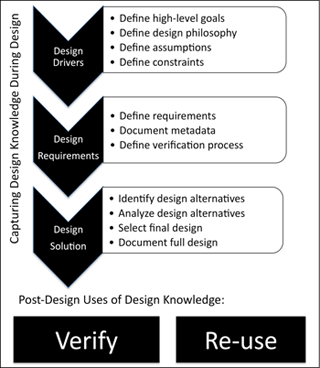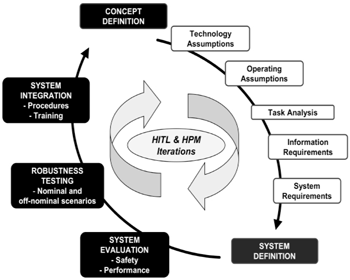|
|
 |

|
 |
 |
Human-centered system design requires a clear understanding of the user's goals and the system that is being used. During the design process, many choices are made that affect the final design - design rationale and design knowledge capture tools allow the system designer to document the design space. To successfully field a system design, during the design process the designer must ensure that the system is robust to both typical and atypical operating scenarios. This research program explores methodologies and tools for creating effective "human-centered" systems.

The objective of this research theme is to develop tools to aid the designer in capturing and communicating design knowledge and rationale to support design verification, and design re-use.
A wide range of new automation, displays, and technologies are being developed to support NextGen flight deck and air traffic control operations. At the infancy of the design lifecycle, we are in a prime position to ensure that these technologies are designed in accordance with human-centered design principles. One aspect of the human-centered design process that is often overlooked is the critical need to record design rationale and the assumptions underlying the design choices, to enable design verification, to support system evolution by enabling safe changes of the design for future applications (Leveson, 2000). Design rationale includes the reasons behind a design decision, the justification for it, the other alternatives considered, the tradeoffs evaluated, and the argumentation that led to the decision (Lee, 1997). Design rationale information can be used for a variety of reasons such as design verification, and design re-use.
Too often successful system development projects fail to leave a legacy of this design rationale information beyond the physical descriptions of the system. Important information about why the system was designed a certain way, or what design options were considered but rejected, is rarely adequately captured. The underlying intent (i.e., the rationale) for the included decisions is usually lost. Often when this information is captured, it is scattered throughout a collection of paper documents, project and personal notebook entries, and the memory of the designers (Klein, 1993). This makes the design rationale information very difficult to access and use, such that this design knowledge often "goes with the employee".
Designers may fail to adequately capture this information because it is not always clear what information is relevant to capture, especially early in the design process, and because there are very few tools available to support this documentation process. As such, formal methods and tools are required to capture design rationale information.
In collaboration with Imperial College, London (Dr. Marco Aurisicchio), design processes and tools are being developed to address the following:
1. Requirements Rationale
- Justification/ rationale for a requirement set; why a requirement is included and how it is satisfied
- Integration with systems engineering methods and tools; software development and V&V tools
2. System Evolution and Traceability
- Evolution of requirements and design over time
- Design knowledge re-use
3. Modeling system states of a complex system
- Modeling dynamic states over time
- Modeling nominal and failure states
Go to: Human-Centered System Design Tools and Methodologies: Design Rationale / Design Knowledge Capture Publications Available For Download
 An important challenge facing system developers is to ensure that a fielded system "scales-up" from laboratory evaluations. Discovering previously unknown interactions, errors, or other negative impacts when the system is fielded may lead to costly setbacks. These setbacks may take the form of unacceptable user demands, poor user/system performance, or user non-acceptance, which, in the extreme, could result in the system being abandoned. Off-nominal testing, in which unexpected or non-nominal conditions are evaluated, is proposed as a method to meet this challenge. Off-nominal testing allows for increased understanding of the human-machine system under evaluation, may uncover design issues that can be addressed, and may help determine training issues and procedures. The objective of this research theme is to develop methodologies to identify potential off-nominal events for consideration in system design to ensure overall system robustness when fielded.
An important challenge facing system developers is to ensure that a fielded system "scales-up" from laboratory evaluations. Discovering previously unknown interactions, errors, or other negative impacts when the system is fielded may lead to costly setbacks. These setbacks may take the form of unacceptable user demands, poor user/system performance, or user non-acceptance, which, in the extreme, could result in the system being abandoned. Off-nominal testing, in which unexpected or non-nominal conditions are evaluated, is proposed as a method to meet this challenge. Off-nominal testing allows for increased understanding of the human-machine system under evaluation, may uncover design issues that can be addressed, and may help determine training issues and procedures. The objective of this research theme is to develop methodologies to identify potential off-nominal events for consideration in system design to ensure overall system robustness when fielded.
Go to: Human-Centered System Design Tools and Methodologies: Off-nominal / Robustness Testing Publications Available For Download |
|
|